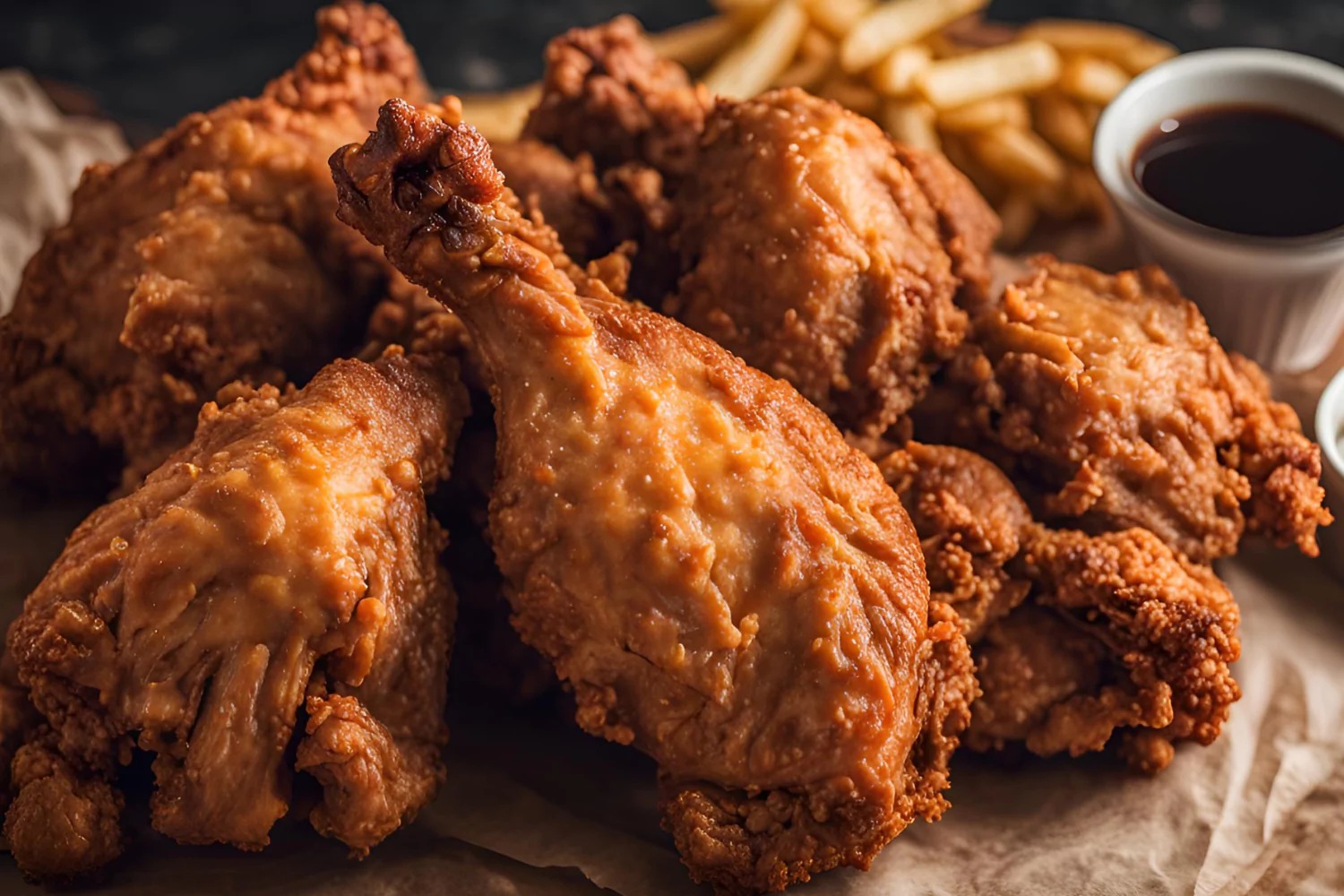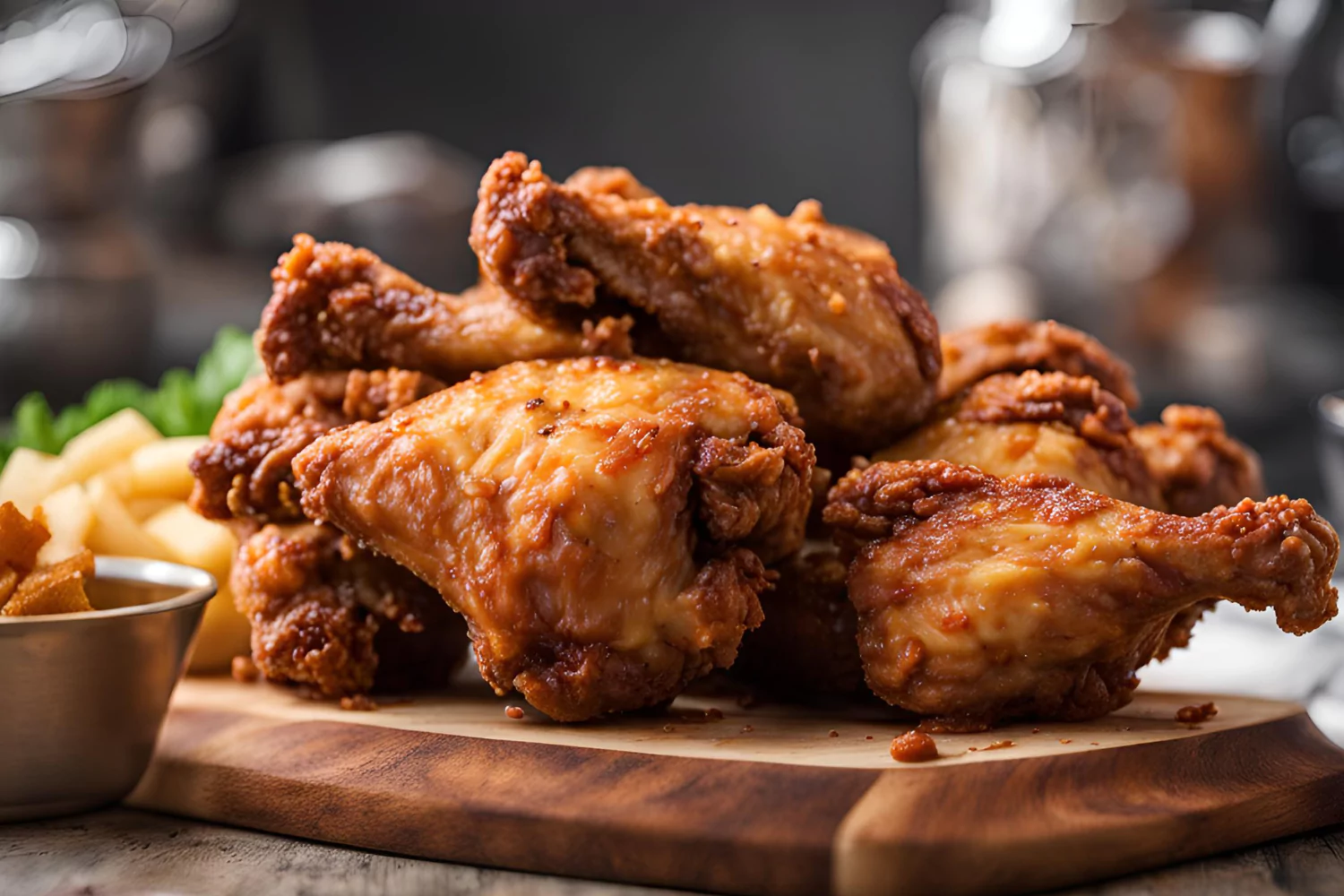Fried chicken is a beloved comfort food, enjoyed by many across the globe. However, it often raises questions about its calorie content and nutritional value. This comprehensive guide will break down the calories in different parts of fried chicken, explore how various cooking methods affect these numbers, and offer tips for making healthier choices. Let’s dive in!
Introduction to Calories in Fried Chicken
Fried chicken is a staple in many cuisines, but it’s not always clear how many calories we’re consuming with each crispy bite. Making educated dietary decisions can be aided by knowing the calorie content. In this section, we’ll introduce the concept of calories and their importance in our diet.
What are Calories?
Calories are a measure of energy. They indicate how much energy food will provide to the body when consumed. Maintaining a balance between calorie intake and energy expenditure is crucial for managing weight and overall health.
How are Calories in Food Measured?
Calories in food are typically measured using a bomb calorimeter, which calculates the energy released by burning food. For packaged foods, manufacturers often provide calorie information based on standardized measurements and ingredient analysis.
By understanding these basics, we can better appreciate the details in the following sections where we break down the calorie content of different parts of fried chicken.
Calories in Different Parts of Fried Chicken
Not all fried chicken pieces are created equal when it comes to calorie content. Factors like the cut of chicken, cooking method, and whether the skin is included can significantly impact the calorie count.
Calories in Drumsticks
Chicken drumsticks are a popular choice for fried chicken lovers. On average, a drumstick can contain between 120 to 250 calories depending on its size and breading (Nutritionix). Typically, drumsticks have a higher calorie count due to the presence of both meat and skin.
Calories in Chicken Breasts
Chicken breasts are often considered a healthier option, but they can still pack a calorie punch when fried. A fried chicken breast with skin can have approximately 271 to 435 calories (CalorieKing). The calorie content can vary based on the breading and the cooking method.
Calories in Wings
Fried chicken wings are a favorite at many gatherings and sports events. A single wing can range from 100 to 200 calories (Chef’s Resource). Wings often have more calories due to their higher fat content and the additional oil absorbed during frying.
Calories in Thighs
Chicken thighs are another popular choice, known for their juicy and flavorful meat. A fried chicken thigh with skin can contain around 230 to 313 calories (CalorieKing). Thighs usually have more fat than breasts, contributing to their higher calorie content.
Factors Affecting Calorie Content

The way fried chicken is prepared can greatly influence its calorie content. Let’s explore how different cooking methods and ingredients impact the calories in your favorite fried chicken pieces.
Cooking Methods and Their Impact
Different cooking methods can lead to variations in calorie content. Deep-frying tends to add the most calories due to the oil absorbed during cooking. Pan-frying might have slightly fewer calories, while baking and air-frying are the healthier alternatives, as they use less or no oil (Chef’s Resource).
Influence of Breading and Coating
The type of breading and coating used on fried chicken can significantly affect its calorie content. Heavy batter or multiple layers of breading increase the calorie count compared to lighter coatings or no breading at all. Ingredients like flour, breadcrumbs, and seasonings all add to the total calorie content (Verywell Fit).
Fast Food vs. Homemade Fried Chicken
Fried chicken from fast-food chains can differ significantly in calorie content compared to homemade versions. Fast food options often include extra breading and are deep-fried, making them higher in calories.
Caloric Content in Fast Food Fried Chicken
Fast food fried chicken is known for its crispy texture and savory taste, but it often comes with a high calorie count. For example, a typical piece of fried chicken from KFC can contain anywhere from 300 to 700 calories depending on the size and preparation (CalorieKing). The extra breading and oil absorption significantly increase the calorie content.
Different fast food outlets have varying calorie counts for their fried chicken:
- KFC Original Recipe Chicken Breast: About 390 calories.
- Popeyes Spicy Chicken Wing: Approximately 210 calories per piece.
- Chick-fil-A Fried Chicken Sandwich: Around 440 calories.
The additional breading and frying methods used by these chains add to the overall calorie content, making them higher than homemade options (FastFoodNutrition.org).
How to Estimate Calories in Homemade Fried Chicken
Homemade fried chicken allows for more control over ingredients and cooking methods, leading to potentially lower calorie counts. To estimate the calories, consider the following:
- Chicken Parts: Choose leaner cuts like skinless chicken breasts to reduce calories.
- Breading: Use lighter coatings such as whole wheat flour or panko breadcrumbs.
- Cooking Method: Opt for baking or air-frying instead of deep-frying.
To calculate the calorie content of homemade fried chicken, tally the calories of each ingredient. For example, a homemade fried chicken breast might have around 250-350 calories, depending on the preparation (Chef’s Resource).
Health Considerations
Fried chicken is delicious, but it’s essential to consider its nutritional value and potential health impacts.
Nutritional Value of Fried Chicken
Fried chicken provides a substantial amount of protein, essential for muscle growth and repair. However, it also contains significant amounts of fat, especially saturated fat, which can be concerning if consumed in excess.
Here’s a typical nutritional breakdown of fried chicken:
- Protein: 24-62 grams per piece, depending on the cut (CalorieKing).
- Fat: 10-20 grams per piece, with a mix of saturated, monounsaturated, and polyunsaturated fats.
- Vitamins and Minerals: Fried chicken can provide vitamins like niacin (B3) and minerals such as phosphorus and selenium (Eat This Much).
Health Risks and Benefits
While fried chicken can be a good source of protein, it also has potential health risks:
- High Calorie Count: Regular consumption of high-calorie foods can lead to weight gain and obesity.
- Saturated Fat: Excessive intake of saturated fats can increase the risk of heart disease.
- Sodium: Many fried chicken recipes are high in sodium, which can contribute to hypertension.
To mitigate these risks, enjoy fried chicken in moderation and balance it with healthier options. Consider removing the skin and opting for baking or air-frying to reduce the calorie and fat content.
Calorie Breakdown by Chicken Part
Different parts of the chicken have varying calorie counts, especially when fried. Let’s take a closer look at how these differences stack up.
Calories in Chicken Drumsticks
Chicken drumsticks are a popular choice for many due to their flavor and convenience. A single fried drumstick can contain between 120 to 250 calories, depending on size and breading used (Nutritionix, Verywell Fit). They are often higher in calories because they include both meat and skin, which absorbs additional oil during frying.
Calories in Chicken Breasts
Chicken breasts are often chosen for their high protein content. However, a fried chicken breast can contain 271 to 435 calories per piece (CalorieKing, Eat This Much). The calorie content varies significantly based on whether the skin is included and the type of breading used. Skinless options and lighter breading can help reduce the calorie count.
Calories in Chicken Wings
Fried chicken wings are a staple at many gatherings. The calorie count for a single wing ranges from 100 to 200 calories, largely due to the breading and oil absorption (Chef’s Resource). Despite their small size, wings can be quite calorie-dense because of their fat content.
Calories in Chicken Thighs
Chicken thighs are known for their juicy texture and rich flavor. A fried chicken thigh can range from 230 to 313 calories (CalorieKing, Chef’s Resource). Thighs tend to have more fat than breasts, which contributes to their higher calorie count.
Factors Affecting Calorie Content

The way fried chicken is prepared can drastically alter its calorie content. Let’s explore how different methods and ingredients play a role.
Cooking Methods and Their Impact
Cooking methods significantly affect the calorie content of fried chicken. Deep-frying typically adds the most calories because the chicken absorbs more oil. In contrast, pan-frying might have fewer calories, while baking and air-frying are the healthier options, requiring less or no oil (Chef’s Resource, Verywell Fit).
For instance:
- Deep-fried: Absorbs a lot of oil, increasing calorie content.
- Pan-fried: Uses less oil, resulting in slightly fewer calories.
- Baked: Uses minimal oil, leading to a significant reduction in calories.
- Air-fried: Uses hot air circulation to achieve a crispy texture with minimal or no oil.
Influence of Breading and Coating
The breading and coating used on fried chicken also impact its calorie count. Heavy batters or multiple layers of breading add more calories compared to lighter coatings. Ingredients like flour, breadcrumbs, and seasonings contribute to the overall calorie content (Verywell Fit, Chef’s Resource).
For example:
- Heavy batter: Higher calorie count due to more ingredients and oil absorption.
- Light breading: Lower calorie count, especially when using whole wheat flour or panko breadcrumbs.
- No breading: Significantly fewer calories, relying on spices for flavor.
Health Considerations
While fried chicken is delicious, it’s important to consider its nutritional value and potential health impacts.
Nutritional Value of Fried Chicken
Fried chicken provides a good amount of protein, essential for muscle growth and repair. However, it also comes with significant fat content, particularly saturated fat, which can be concerning if consumed excessively (Eat This Much).
Typical nutritional breakdown:
- Protein: 24-62 grams per piece, depending on the cut.
- Fat: 10-20 grams per piece, including saturated, monounsaturated, and polyunsaturated fats.
- Vitamins and Minerals: Provides vitamins like niacin (B3) and minerals such as phosphorus and selenium.
Health Risks and Benefits
Although fried chicken can be a great source of protein, it also poses health risks:
- High Calorie Count: Regular consumption can lead to weight gain and obesity.
- Saturated Fat: Excessive intake increases the risk of heart disease.
- Sodium: High sodium content can contribute to hypertension.
To enjoy fried chicken while maintaining a healthy diet, consider these tips:
- Moderation: Enjoy fried chicken occasionally as part of a balanced meal.
- Healthier Preparations: Opt for baking or air-frying to reduce calorie and fat content.
- Lean Cuts: Choose skinless chicken breasts to lower the fat content.
- Balanced Meals: Pair fried chicken with nutritious sides like vegetables and whole grains.
Making Healthier Fried Chicken Choices

Fried chicken can be part of a balanced diet if you make informed choices. Here are some tips for enjoying this delicious dish while keeping it healthier.
Choose Lean Cuts
Opt for skinless chicken breasts instead of thighs or wings. Skinless breasts are lower in fat and calories but still provide a good amount of protein. By removing the skin, you significantly reduce the fat content, making your fried chicken a healthier option (Verywell Fit, CalorieKing).
Use Healthier Breading and Coatings
Traditional breading can add a lot of calories and fat to fried chicken. To make it healthier, use lighter alternatives like whole wheat flour, panko breadcrumbs, or even crushed cornflakes. These options provide a satisfying crunch without the extra calories and fat (Chef’s Resource).
Cooking Methods to Reduce Calories
The way you cook your fried chicken can greatly affect its calorie content. Here are some healthier cooking methods:
- Baking: Instead of deep-frying, bake your chicken in the oven. This method uses less oil and can still result in a crispy texture.
- Air-frying: Air fryers use hot air to cook the chicken, giving it a crispy exterior with minimal oil.
- Pan-frying: Use a minimal amount of healthy oil like olive oil or canola oil to reduce calorie intake.
Flavor Without the Calories
Enhance the flavor of your fried chicken without adding extra calories by using herbs and spices. Paprika, garlic powder, onion powder, and cayenne pepper can add a lot of flavor without the need for heavy breading or high-calorie sauces (Verywell Fit).
Portion Control
Be mindful of portion sizes. Larger pieces of fried chicken contain more calories. Opt for smaller portions and balance your meal with healthy sides like vegetables or a salad. This approach helps you enjoy fried chicken without overindulging (CalorieKing, Nutritionix).
Additional Tips for Healthier Fried Chicken
Here are some additional tips to make your fried chicken experience healthier:
- Drain Excess Oil: After frying, place the chicken on a paper towel to absorb excess oil.
- Homemade Sauces: Create your own low-calorie dipping sauces using ingredients like Greek yogurt, mustard, and fresh herbs.
- Pair with Healthy Sides: Serve fried chicken with steamed vegetables, quinoa, or a fresh salad to create a balanced meal.
FAQs
In this section, we’ll address some frequently asked questions about the calorie content and health aspects of fried chicken.
Are There Any Variations in Calories Depending on the Frying Method?
Yes, the frying method can impact calorie content. Pan-fried chicken usually contains fewer calories than deep-fried chicken because it absorbs less oil (Chef’s Resource).
Does the Size of the Chicken Piece Affect the Calorie Count?
Absolutely. Larger pieces of chicken will generally have more calories compared to smaller ones. It’s crucial to consider portion sizes when calculating calorie content.
How Can I Make Fried Chicken Healthier?
To make fried chicken healthier, choose leaner cuts like skinless breast meat, use less oil for frying, and opt for lighter breading options or alternative coatings like crushed cornflakes.
Can I Still Enjoy Fried Chicken as Part of a Balanced Diet?
Yes, moderation is key. Enjoying fried chicken occasionally as part of a balanced meal, accompanied by nutritious sides and vegetables, can be a flavorful addition without sabotaging your overall health goals.
By following these tips and considering the nutritional information, you can enjoy fried chicken while maintaining a healthy diet.
Conclusion
Understanding the calorie content in fried chicken and making informed choices can help you enjoy this delicious dish without guilt. By opting for healthier cuts, using lighter breading, and choosing better cooking methods, you can reduce the calories and still enjoy the crispy, savory goodness of fried chicken.
By incorporating these tips and being mindful of portion sizes and ingredients, you can make fried chicken a part of a balanced diet. So, go ahead and enjoy your favorite comfort food, but do so wisely and healthily!

